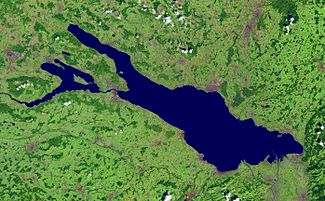Lake Constance
| Lake Constance Bodensee |
|
|---|---|

satellite image
|
|

map
|
|
| Location | Germany, Switzerland, Austria |
| Coordinates | 47°35′N 9°28′E / 47.583°N 9.467°ECoordinates: 47°35′N 9°28′E / 47.583°N 9.467°E |
| Primary inflows | Rhine |
| Primary outflows | Rhine |
| Catchment area | 11,500 km2 (4,400 sq mi) |
| Basin countries | Germany, Switzerland, Austria |
| Max. length | 63 km (39 mi) |
| Max. width | 14 km (8.7 mi) |
| Surface area | 571 km2 (220 sq mi) |
| Average depth | 90 m (300 ft) |
| Max. depth | 251 m (823 ft) |
| Water volume | 51.4 km3 (12 cu mi) |
| Residence time | 4.3 years |
| Surface elevation | 395 m (1,296 ft) |
| Frozen | 1795, 1830, 1880 (partial), 1963 |
| Islands | Mainau, Reichenau, Lindau |
| Sections/sub-basins | Obersee, Überlinger See; Untersee, Zeller See, Gnadensee |
| Settlements | see list |
Lake Constance (German: Bodensee) is a lake on the Rhine at the northern foot of the Alps, and consists of three bodies of water: the Obersee ("upper lake"), the Untersee ("lower lake"), and a connecting stretch of the Rhine, called the Seerhein.
The lake is situated in Germany, Switzerland and Austria near the Alps. Its shorelines lie in the German states of Bavaria and Baden-Württemberg, the Austrian state of Vorarlberg, and the Swiss cantons of Thurgau, St Gallen and Schaffhausen. The river Rhine flows into the lake from the south, with its original course forming the Austro-Swiss border, and has its outflow of the "Lower Lake" where - except from Schaffhausen, see above - it forms the German-Swiss border until the city Basel.
Freshwater Lake Constance is central Europe's third largest, after Lake Balaton and Lake Geneva. It is 63 km (39 mi) long, and at its widest point, nearly 14 km (8.7 mi). It covers approximately 571 km2 (220 sq mi), and is 395 m (1,296 ft) above sea level. The greatest depth is 252 metres (827 ft) in the middle of the eastern part (Obersee). Its volume is approximately 10×109 m3 (13×109 cu yd). The lake has four parts: the main section, called Obersee, 476 km2 (184 sq mi); the north section, Überlinger See, 61 km2 (24 sq mi); the west section, Untersee, 63 km2 (24 sq mi); and the northwest section, the Zeller See and Gnadensee. The regulated Rhine flows into the lake in the southeast, through the Obersee, the city of Konstanz and the Untersee, and flows out near Stein am Rhein. The lake itself is an important drinking water source for southwestern Germany, called Bodensee-Wasserversorgung ("Lake Constance Water Supply"). The culminating point of the lake's drainage basin is the Tödi at 3,614 metres above sea level.
...
Wikipedia
